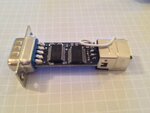David_
Advanced Member level 2

- Joined
- Dec 6, 2013
- Messages
- 573
- Helped
- 8
- Reputation
- 16
- Reaction score
- 8
- Trophy points
- 1,308
- Location
- Sweden
- Activity points
- 12,242
Hello.
I've bought a USB-Serial/RS-232 converter, not a cheap one of ebay but a real unit with:
Asynchronous Serial Protocol: RS-232
TD, RD, DCD, DTR, GND, SDR, RTS, CTS, RI
Data Rate: Up to 460.8 Kbps
USB: 12Mbits
And I wanted to use this to communicate with my micrcontrollers and I have a few MAX232 ICs, so I thought to solder one of those to a little board with a DB9 female connector.
But when I came to the issue of supplying MAX232 with +5V I turned to opening up the dongle to see if I could get the USBs 5V supply out in a simple way.

But when I opened it I saw that the converter utilizes a FT232RL together with a SP3243EUEA.
SP3243 is a High Speed Intelligent +3.0V to +5.5V RS-232 Transceivers, and FT232RL is a USB UART IC.
And seeing as I know that FT232RL is a common solution for people to connect to µC's through USB I thought "do I really need MAX232?", but I don't know and I can't as of jet figure out the function of SP3243.
I will draw up a schematic and post asap but I figured I could ask you folks in the mean time.
The dongle outputs around 5,5 to 5,9V according to documents.
Regards
I've bought a USB-Serial/RS-232 converter, not a cheap one of ebay but a real unit with:
Asynchronous Serial Protocol: RS-232
TD, RD, DCD, DTR, GND, SDR, RTS, CTS, RI
Data Rate: Up to 460.8 Kbps
USB: 12Mbits
And I wanted to use this to communicate with my micrcontrollers and I have a few MAX232 ICs, so I thought to solder one of those to a little board with a DB9 female connector.
But when I came to the issue of supplying MAX232 with +5V I turned to opening up the dongle to see if I could get the USBs 5V supply out in a simple way.

But when I opened it I saw that the converter utilizes a FT232RL together with a SP3243EUEA.
SP3243 is a High Speed Intelligent +3.0V to +5.5V RS-232 Transceivers, and FT232RL is a USB UART IC.
And seeing as I know that FT232RL is a common solution for people to connect to µC's through USB I thought "do I really need MAX232?", but I don't know and I can't as of jet figure out the function of SP3243.
I will draw up a schematic and post asap but I figured I could ask you folks in the mean time.
The dongle outputs around 5,5 to 5,9V according to documents.
Regards

